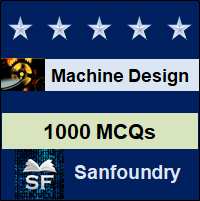This set of Machine Design Multiple Choice Questions & Answers (MCQs) focuses on “Worm Gears”.
1. Worm gear drives are used to transmit power between two non-intersecting shafts which are generally at right angles to each other.
a) True
b) False
View Answer
Explanation: This is how the worm gear design fits into use.
2. The worm and worm wheel both are threaded screw.
a) True
b) Worm wheel is a toothed gear
c) Worm is a toothed gear
d) None of the listed
View Answer
Explanation: Worm wheel is a toothed gear.
3. Which of the following is not true about worm gears?
a) Compact
b) Smooth and silent operation
c) Low speed reduction
d) All the mentioned are true
View Answer
Explanation: Speed reduction can be high up to 100:1.
4. Is it possible to use worm gears in cranes for lifting purpose?
a) True
b) No self-locking and hence not possible
c) Possible up to a threshold load
d) None of the listed
View Answer
Explanation: Worm gears support self-locking operation and hence are advantageous to use in lifting operations.
5. The power transmitting capacity of worm gears is high although efficiency is low.
a) True
b) False
View Answer
Explanation: Both power transmitting capacity and efficiency of worm gears are low.
6. Can worm gears be used in steering mechanism?
a) True
b) False
View Answer
Explanation: In steering mechanism, efficiency is of little importance but major requirement is of large mechanical advantage.
7. The worm helix angle is the _____ of the worm lead angle.
a) Complement
b) Half
c) Double
d) Supplement
View Answer
Explanation: Worm helix angle+worm lead angle=90⁰.
8. If worm helix angle is 30⁰, then worm should have at least ___ threads.
a) 5
b) 6
c) 7
d) 8
View Answer
Explanation: The permissible helix angle is 6⁰ and hence there should be at least five threads i.e. 30/6.
9. A pair of worm gear is written as 2/40/12/6. Calculate the centre distance.
a) 40mm
b) 156mm
c) 200mm
d) 80mm
View Answer
Explanation: C=m(q+z)/2 where m=6mm, q=12 and z=40.
10. A pair of worm gear is written as 2/40/12/6. Calculate the speed reduction.
a) 2
b) 20
c) 15
d) 6
View Answer
Explanation: i=40/2.
11. A pair of worm gear is written as 2/40/12/6. Calculate the pitch circle diameter of worm wheel.
a) 72mm
b) 240mm
c) 260mm
d) 320mm
View Answer
Explanation: d=mxz where m=6mm and z=40.
12. A pair of worm gear is written as 2/40/12/6. Calculate the throat diameter of the worm wheel.
a) 220.5mm
b) 246.4mm
c) 190.44mm
d) 251.7mm
View Answer
Explanation: d(t)=m[z+4cosϒ-2] where ϒ=9.46⁰ is the lead angle. tanϒ=2/12, z=40 and m=6mm.
13. A pair of worm gear is written as 2/40/12/6. Calculate the root diameter of the worm wheel.
a) 186.22mm
b) 250.4mm
c) 225.6mm
d) 250.44mm
View Answer
Explanation: d=m[z-2-0.4cosϒ] where ϒ=9.46⁰ is the lead angle. tanϒ=2/12, z=40 and m=6mm.
14. If tangential force on worm is 1500N, then axial force on worm wheel will be?
a) 1500N
b) 3000N
c) 1500√2 N
d) 750N
View Answer
Explanation: P₂(axial)=P₁(tangential).
Sanfoundry Global Education & Learning Series – Machine Design.
To practice all areas of Machine Design, here is complete set of 1000+ Multiple Choice Questions and Answers.
If you find a mistake in question / option / answer, kindly take a screenshot and email to [email protected]
- Apply for Metallurgical Engineering Internship
- Check Machine Design Books
- Practice Mechanical Engineering MCQs
- Check Metallurgical Engineering Books
- Apply for Mechanical Engineering Internship

